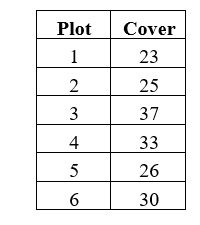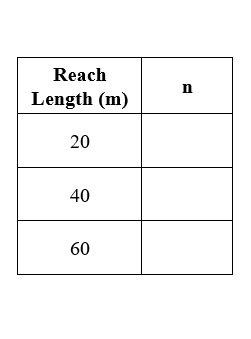NR 421 – Assignment #3
Benefits and Calculations of Systematic Sampling Designs
Objective: This assignment will ask you to describe the spatial arrangement of natural populations and why this is important in sampling. Additionally, you will explore the role of sample spacing and the benefits of systematic sampling.
Student Learning Outcomes: Upon completing this assignment should be able to:
- Explain the role of a populations spatial arrangement in sampling.
- Demonstrate a mastery of sample size calculations.
- Determine the spacing needed between systematic samples.
- Start to understand how the sampling unit can impact a population sampling distribution.
1. From the following preliminary sample of 9 m2 plots observing shrub density in a 12 hectare management unit, estimate how many plots you would need at an allowable error of 5% and 95% confidence. Be sure to determine if you need to account for the finite population correction factor in your calculations.

2. From question 1, how many plots do you need to reach the allowable error of 5% and 95% confidence if you decide to increase the plot size to 25 m2?
3. How are natural populations typically arranged in a landscape? What leads to this arrangement?
4. What do semi-variograms tell us about the relationship between your plots?
5. Why are systematic samples often implemented in forestry instead of a random sampling? What assumptions must we make about systematic sampling to apply the statistics of simple random sampling?
6. You have been assigned to design a systematic monitoring program for the assessment of range forage biomass and present it to your boss. The only guidance he provided you is that there are 46,000 acres to inventory, you need a sampling intensity that would equal measuring 0.005% of the acreage every 5 years. You decide to give options of different size fixed area plots, complete the table below in chains.

7. Your boss in Question # 6 then asked you to pick and defend which plot size, sample size, and spacing, you would choose? Remember to consider both efficiency and statistical validity in your decision.
8. You are the new Fisheries Biologist assigned to the Arapaho-Rosevelt National Forest and your first task is to design an electrofishing sample scheme to determin the trout population in Joe Wright Creek. You know that the creek is 1.4 km long and that a survey 10 years ago showed that the population density was 4.2 fish per 20 m reach and varied by 33% when sampled with 20 m long stream segments. Just to me thurough you decide to determine how many sample stream segments you will need to reach an estimate of the population size to within 10% at 95% confidence at each of the below reach lengths. Be sure to consider the finite population correction factor when selecting which sample size formula to use.

